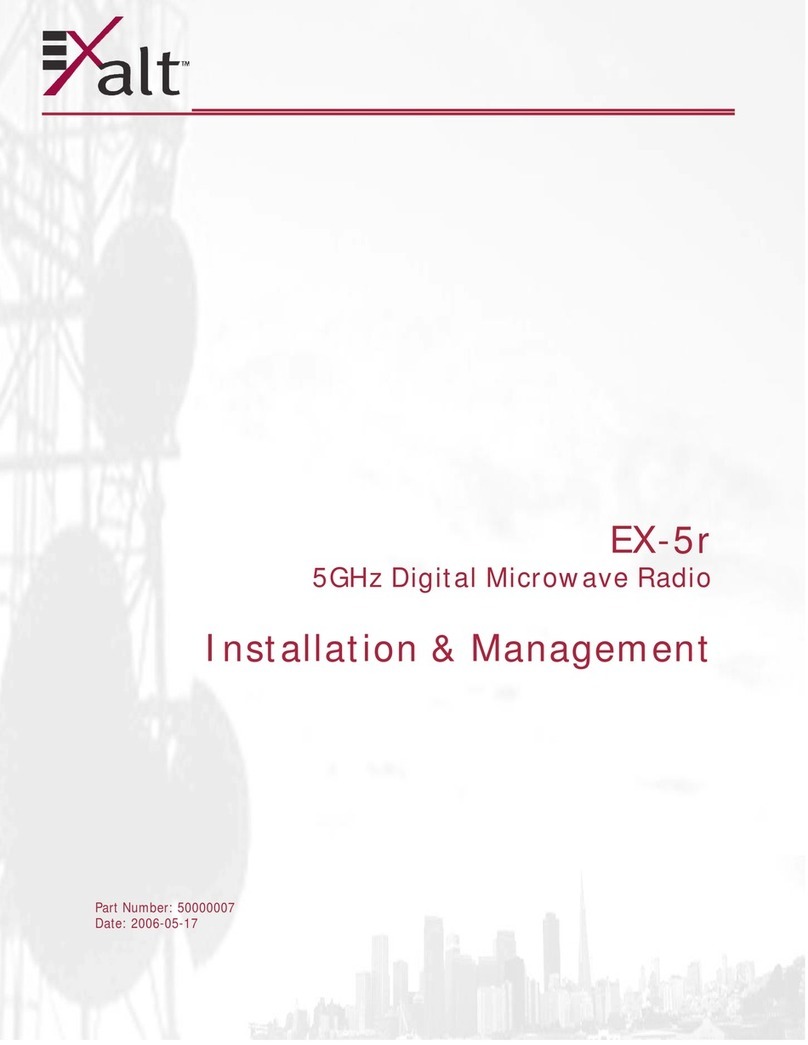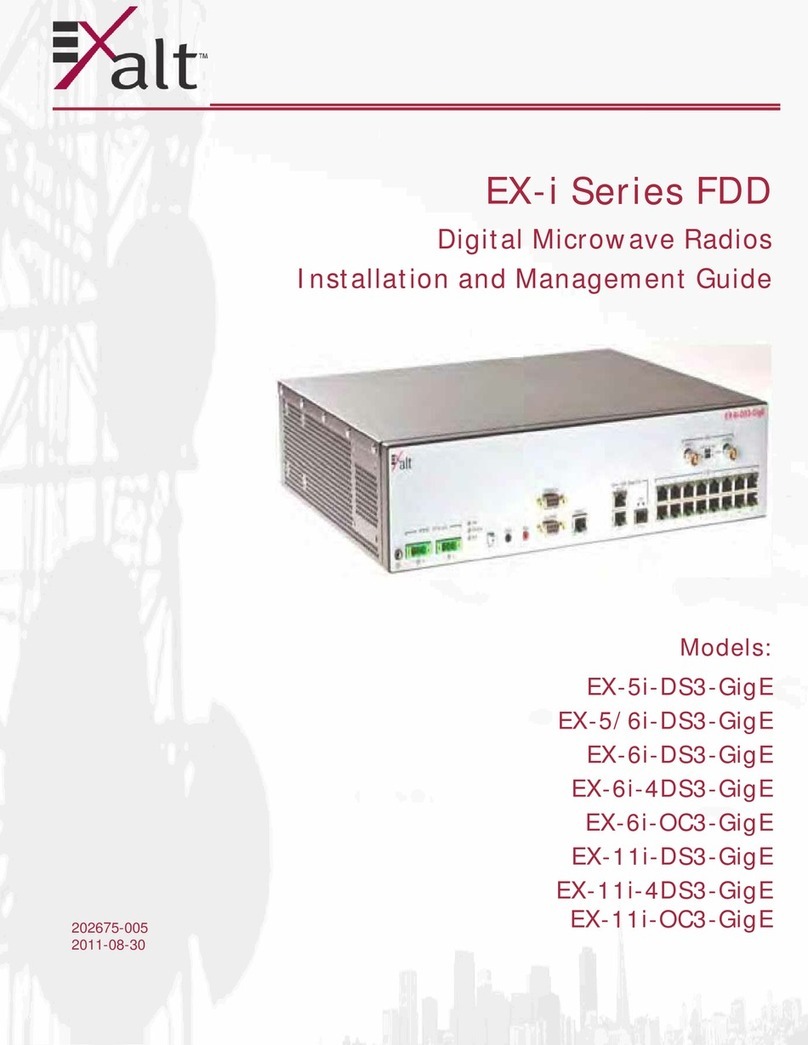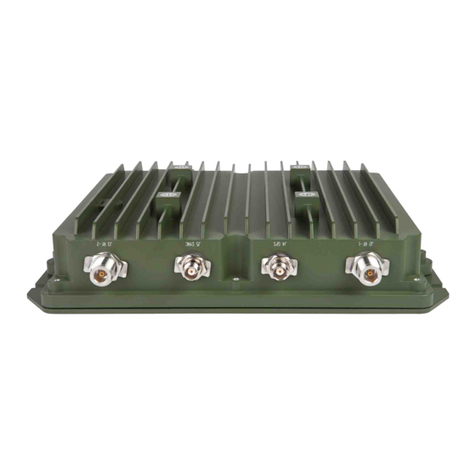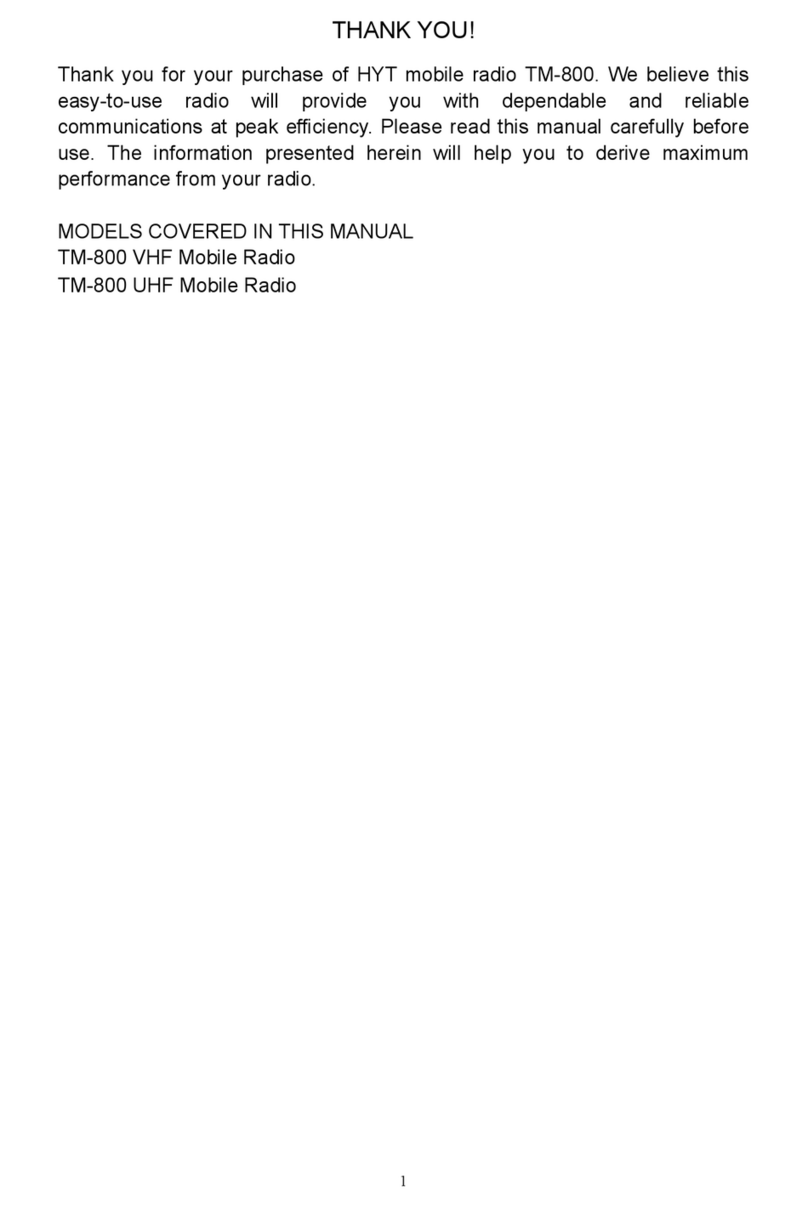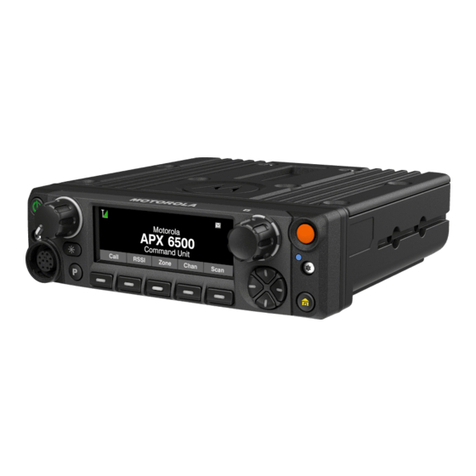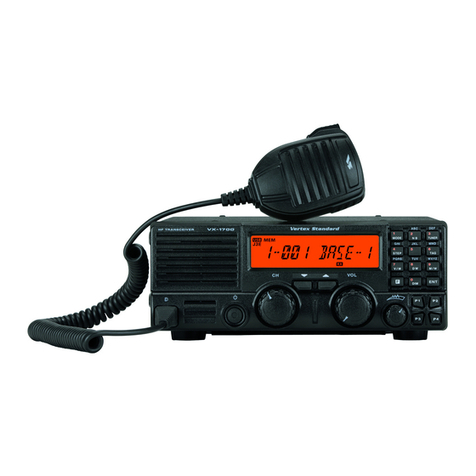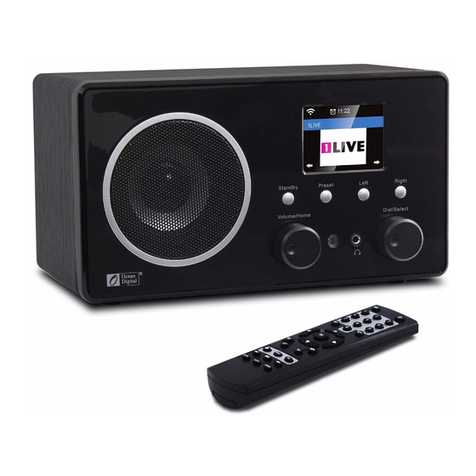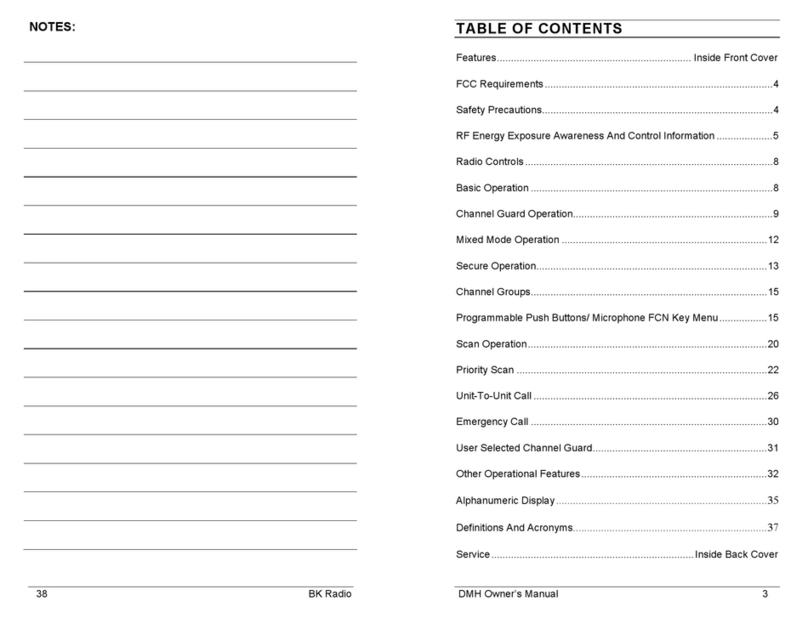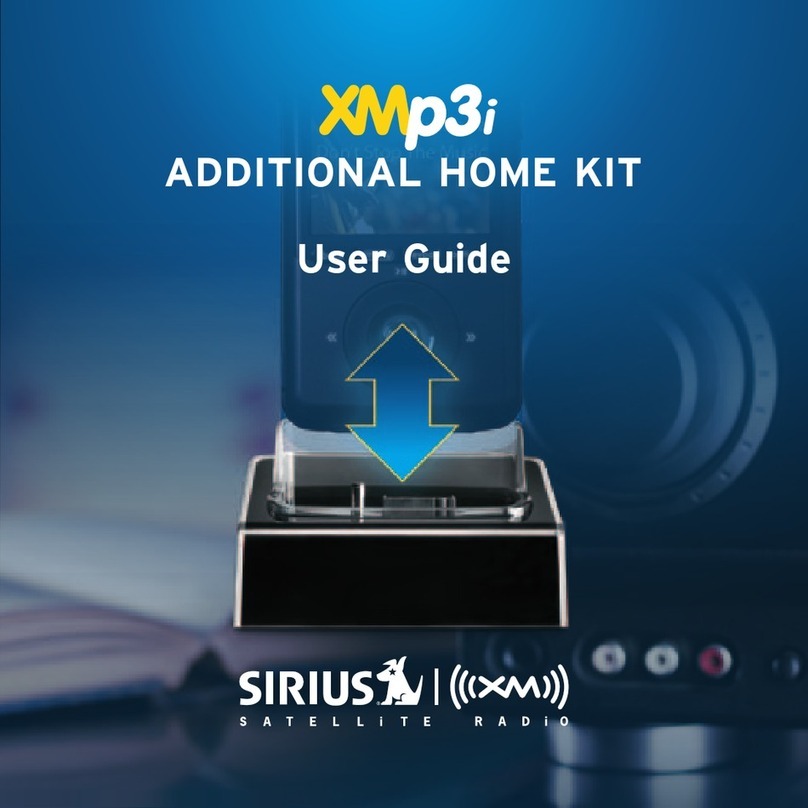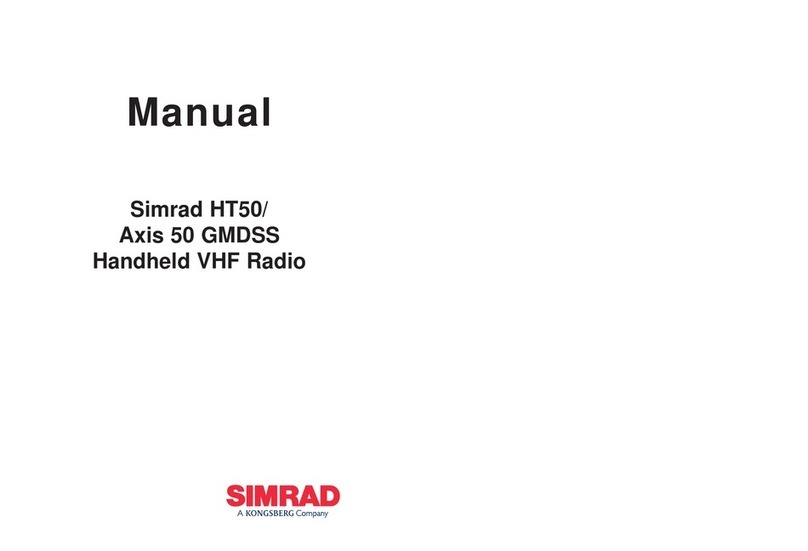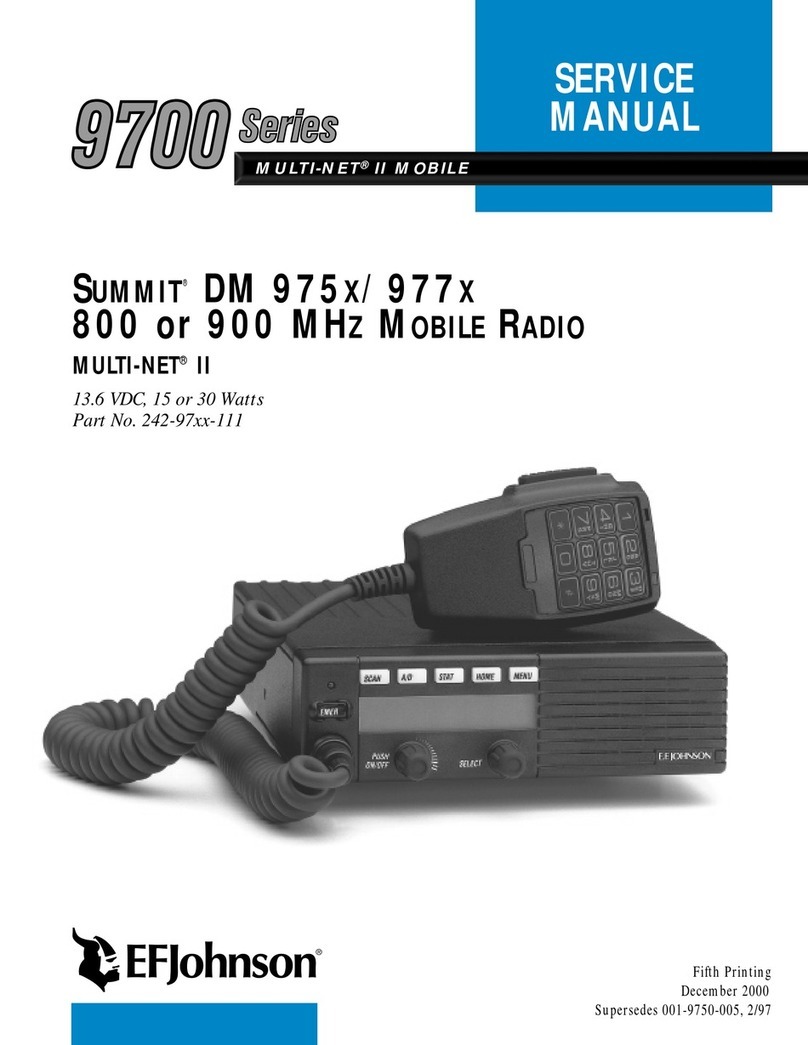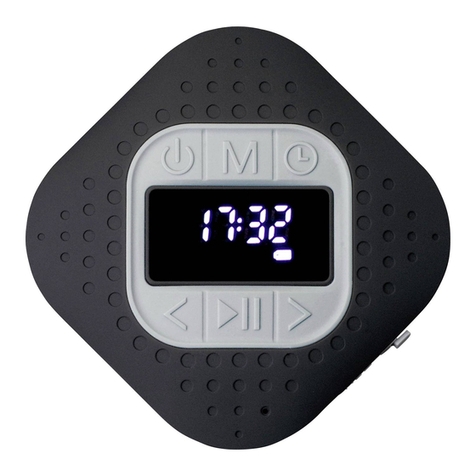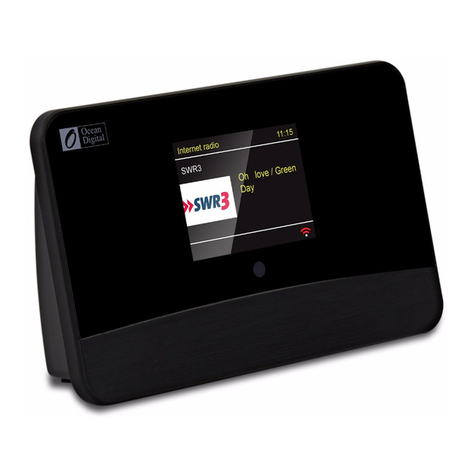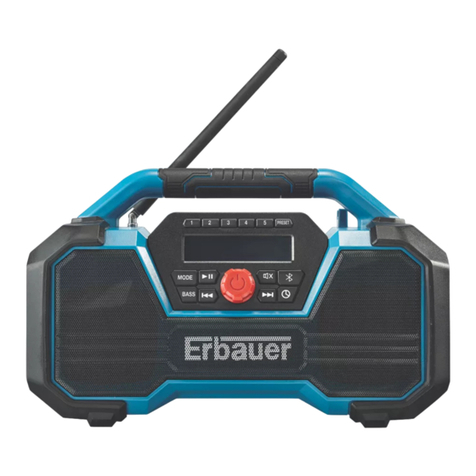Exalt S Series Programming manual

Part Number: 201511
Date: 2008-02-27
s-Series
Digital Microwave Radios
Installation and Management Guide
Models:
EX-11s
EX-11s-16
EX-18s
EX-18s-16
EX-23s
EX-23s-16

Exalt Installation and Management Guide
s-Series Digital Microwave Radios
ii 201511
2008-02-27
Legal Notice
The information contained herein is the property of Exalt Communications, Inc. (―Exalt‖) and is
supplied without liability for errors or omissions. No part of this document may be reproduced, in any
form, except as authorized by contract or other written permission from the owner.
Any brand names and product names included in this manual are trademarks, registered trademarks,
or trade names of their respective holders.
The contents of this document are current as of the date of publication. Exalt reserves the right to
change the contents without prior notice.
The publication of information in this document does not imply freedom from patent or other rights
of Exalt or others.
© 2008 Exalt Communications Inc. All rights reserved.
The Exalt logo is a trademark of Exalt Communications, Inc.
Open-Source License Information
In addition to proprietary software/firmware, which is the sole intellectual property of Exalt, the Exalt
i-series Digital Microwave Radios make use of public (open-source) software/firmware within the
terms of use of their respective shared license agreements. Exalt will supply copies of any of this code,
within the terms of their individual licensing agreements, upon request.
Open-Source Code
License Agreement
Website
Linux Operating System
GNU GPL Version 2
www.gnu.org
BusyBox CLI
GNU GPL Version 2
www.gnu.org
www.busybox.net
GoAhead Web Server
Copyright (c) 2003 GoAhead Software, Inc. All Rights
Reserved.
www.goahead.com
U-boot Boot Code
GNU GPL Version 2
www.gnu.org
www.sourceforge.net
Net-SNMP
(see Copyright Notices)
www.sourceforge.net

Exalt Installation and Management Guide
s-Series Digital Microwave Radios
201511 iii
2008-02-27
Table of Contents
Legal Notice...........................................................................................................................................ii
Open-Source License Information .........................................................................................................ii
List of Figures .......................................................................................................................................vi
List of Tables.......................................................................................................................................viii
About this Document..............................................................................................................................1
Revision History.................................................................................................................................1
Icons ...................................................................................................................................................1
Introduction............................................................................................................................................2
Related Documentation and Software................................................................................................2
The Exalt s-Series Digital Microwave Radios ...................................................................................2
Basic Features.....................................................................................................................................6
Pre-installation Tasks .............................................................................................................................8
Link Engineering and Site Planning...................................................................................................8
Familiarization with the s-Series Radios............................................................................................9
Shipping Box Contents...................................................................................................................9
Initial Configuration and Back-to-Back Bench Test..........................................................................9
RF Output Power Setting .................................................................................................................10
General Radio Configuration ...........................................................................................................11
System Installation and Initiation Process............................................................................................12
Record Keeping................................................................................................................................13
Installation............................................................................................................................................14
Mechanical Configuration and Mounting ........................................................................................14
Rack Mounting the IDU...............................................................................................................14
Mounting the Outdoor Unit (ODU)..............................................................................................15
Table or Rack Shelf Mounting the System...................................................................................16
Radio Ports and Indicators................................................................................................................17
Connector Overview.....................................................................................................................17
LED Indicators .............................................................................................................................19
RMT (Remote) Button .................................................................................................................21
Power................................................................................................................................................21
The TO ODU Connector..............................................................................................................21
AC Power .....................................................................................................................................21
DC Power .....................................................................................................................................22

Exalt Installation and Management Guide
s-Series Digital Microwave Radios
iv 201511
2008-02-27
Reset to Critical Factory Settings................................................................................................. 23
Coaxial Cabling between IDU and ODU......................................................................................... 24
Lightning and Surge Protection for the IDU/ODU Cable............................................................ 25
Antenna/Transmission System......................................................................................................... 25
Initial Antenna Mounting............................................................................................................. 25
Installing the IDU-to-ODU Cable................................................................................................ 26
Antenna Alignment.......................................................................................................................... 27
Configuration and Management........................................................................................................... 28
Command Line Interface (CLI) ....................................................................................................... 28
Connect to the Radio with a Serial Connection........................................................................... 28
Telnet into the Command Line Interface (CLI)............................................................................... 28
Connect to the Radio in a Telnet Session..................................................................................... 28
Exalt Graphical User Interface (GUI).............................................................................................. 29
Preparing to Connect.................................................................................................................... 29
Log In........................................................................................................................................... 29
Login Privileges........................................................................................................................... 30
Quick Start....................................................................................................................................... 31
Navigating the GUI.......................................................................................................................... 32
Summary Status Section .............................................................................................................. 32
Navigation Panel.......................................................................................................................... 33
Radio Information Page................................................................................................................... 34
Administration Settings Page........................................................................................................... 35
System Configuration Page.............................................................................................................. 37
Ethernet Interface Configuration Page............................................................................................. 39
T1/E1 Configuration Pages.............................................................................................................. 40
T1 Interface Configuration Page.................................................................................................. 41
E1 Interface Configuration Page.................................................................................................. 42
T1/E1 Loopback........................................................................................................................... 42
File Transfer Page............................................................................................................................ 44
File Activation Page......................................................................................................................... 47
Alarms Page..................................................................................................................................... 48
Performance Page ............................................................................................................................ 50
Event Log Page................................................................................................................................ 52
Diagnostic Charts Page.................................................................................................................... 53
Reset Page........................................................................................................................................ 55

Exalt Installation and Management Guide
s-Series Digital Microwave Radios
201511 v
2008-02-27
Manual Page.....................................................................................................................................56
Specifications .......................................................................................................................................57
Physical Specifications.....................................................................................................................57
Common System Specifications.......................................................................................................57
EX-11s System Specifications .........................................................................................................59
EX-18s System Specifications .........................................................................................................60
EX-23s System Specifications .........................................................................................................61
Interfaces..........................................................................................................................................62
Interface Connections...........................................................................................................................64
T1/E1 Connections...........................................................................................................................64
Ethernet Connections .......................................................................................................................65
Sync Connections.............................................................................................................................65
Alarm Connector..............................................................................................................................66
Console Connector ...........................................................................................................................67
DC Power Connector........................................................................................................................67
Antennas...............................................................................................................................................68
Troubleshooting....................................................................................................................................70
General Practices..............................................................................................................................70
Typical Indications of Issues............................................................................................................71
Multipath Propagation......................................................................................................................72
RF Interference.................................................................................................................................72
Path Obstruction...............................................................................................................................73
Misaligned Antenna .........................................................................................................................73
Faulty Antenna.................................................................................................................................73
Improper Grounding.........................................................................................................................73
Insufficient Link Margin ..................................................................................................................73
Bench Testing.......................................................................................................................................74
Over-the-Air Basic Test ...................................................................................................................74
Back-to-Back Bench Test.................................................................................................................75
Specification Performance Verification ...........................................................................................76
General Compliance and Safety...........................................................................................................78
Safety Notices.......................................................................................................................................79
Regulatory Notices...............................................................................................................................80
United States Compliance ................................................................................................................80
Federal Communications Commission (FCC), United States......................................................80

Exalt Installation and Management Guide
s-Series Digital Microwave Radios
vi 201511
2008-02-27
Canada Compliance......................................................................................................................... 81
Industry Canada (IC), Canada...................................................................................................... 81
Regulatory Compliance ....................................................................................................................... 82
Licensing.............................................................................................................................................. 83
United States.................................................................................................................................... 83
Canada ............................................................................................................................................. 83
Exalt Limited Hardware Warranty....................................................................................................... 84
Registration...................................................................................................................................... 84
Exclusions........................................................................................................................................ 84
RMA Procedures.............................................................................................................................. 84
Copyright Notices................................................................................................................................ 86
Index .................................................................................................................................................... 91
List of Figures
Figure 1 Exalt s-Series Digital Microwave Radio IDU.................................................................... 2
Figure 2 s-Series Digital Microwave Radio ODU............................................................................ 3
Figure 3 Indoor mounted IDU interconnection with Direct-Mount ODU ...................................... 6
Figure 3 Indoor mounted IDU interconnection with Remote-Mounted ODU ................................ 6
Figure 5 Radio installation tasks .................................................................................................... 12
Figure 1 Front flush mount configuration...................................................................................... 14
Figure 2 Front projection mount configuration.............................................................................. 15
Figure 3 Rear-mount locations....................................................................................................... 15
Figure 4 ODU—waveguide slot..................................................................................................... 16
Figure 5 ODU—remote mount with flexible waveguide............................................................. 16
Figure 6 EX-s Series front panel.................................................................................................... 17
Figure 7 Primary front panel connectors (standard models) .......................................................... 17
Figure 8 DC connector ................................................................................................................... 23
Figure 12 CLI main menu ................................................................................................................ 29
Figure 13 Initiating the browser connection..................................................................................... 30
Figure 14 Browser Login screen ...................................................................................................... 30
Figure 15 Radio Information page ................................................................................................... 31
Figure 16 Exalt GUI window description ........................................................................................ 32
Figure 17 Summary status information............................................................................................ 33
Figure 18 Radio Information page ................................................................................................... 34

Exalt Installation and Management Guide
s-Series Digital Microwave Radios
201511 vii
2008-02-27
Figure 19 Administration Settings page ...........................................................................................35
Figure 20 System Configuration page ..............................................................................................37
Figure 21 Ethernet Interface Configuration page .............................................................................39
Figure 22 T1 Interface Configuration page.......................................................................................41
Figure 23 E1 Interface Configuration page.......................................................................................42
Figure 24 External (remote) loopback..............................................................................................43
Figure 25 External (local) loopback .................................................................................................43
Figure 26 Internal loopback..............................................................................................................43
Figure 27 File Transfer page.............................................................................................................44
Figure 28 File Transfer page—download file link............................................................................45
Figure 29 File Activation page .........................................................................................................47
Figure 30 Alarms page......................................................................................................................48
Figure 31 Performance page.............................................................................................................50
Figure 32 Event Log page.................................................................................................................52
Figure 33 Diagnostic Charts page.....................................................................................................53
Figure 34 Reset page.........................................................................................................................55
Figure 35 Manual page .....................................................................................................................56
Figure 36 T1/E1 connectors..............................................................................................................64
Figure 37 Ethernet connectors (MAIN and AUX)............................................................................65
Figure 38 Alarm Connector..............................................................................................................66
Figure 39 Console Connector ...........................................................................................................67
Figure 40 DC Power Connector........................................................................................................67
Figure 41 Bench back-to-back test configuration.............................................................................76

Exalt Installation and Management Guide
s-Series Digital Microwave Radios
viii 201511
2008-02-27
List of Tables
Table 1 Factory default settings.................................................................................................... 11
Table 2 Connectors ....................................................................................................................... 17
Table 3 LED indicators................................................................................................................. 19
Table 4 Default login information................................................................................................. 31
Table 5 Alarm status indicators..................................................................................................... 48
Table 6 Recommended 11GHz antennas (rectangular waveguide, direct-coupled) ..................... 68
Table 7 Recommended 18GHz antennas (rectangular waveguide, direct-coupled) ..................... 68
Table 8 Recommended 23GHz antennas (rectangular waveguide, direct-coupled) ..................... 68
Table 9 Remote mount solutions (rectangular waveguide)........................................................... 69
Table 10 Flexible rectangular waveguide....................................................................................... 69
Table 11 Product Approvals............................................................................................................ 82

Exalt Installation and Management Guide
s-Series Digital Microwave Radios
201511 1
2008-02-27
About this Document
This manual provides a complete description of the s-Series of Exalt Digital Microwave Radios and
related software. This manual provides planners, engineers, installers, system administrators, and
technicians general and specific information related to the planning, installation, operation,
management, and maintenance of these devices.
Revision History
Date
Products and Release code
2008-02-27
EX-11s, EX-11s-16, EX-18s, EX-18s-16, EX-23s, EX-23s-16 (initial release)
Icons
The following icons denote specific types of information:
Note: This symbol means take note. Notes contain helpful suggestions or
references to materials not contained in the manual.
Warning: This warning symbol means there is a risk of electric shock. This
situation that could cause bodily injury. Before working on any equipment, be
aware of the hazards involved with electrical circuitry and be familiar with standard
practices for preventing accidents.
Caution: This symbol means be careful. There is a risk of doing something that
might result in equipment damage or loss of data. This is a general warning, caution,
or risk of danger.

Exalt Installation and Management Guide
s-Series Digital Microwave Radios
2201511
2008-02-27
Introduction
Exalt Communications, Inc. thanks you for your purchase. Our goal is to build the highest quality,
highest reliability digital microwave radio products. This commitment to quality and reliability
extends to our employees and partners alike. We appreciate any comments on how we can improve
our products, as well as your sales and Customer Care experience.
Customer Care Hotline: (408) 871-9890
USA Toll-Free Customer Care Hotline:: (877) EXALT-01 (392-5801)
Direct-Dial Telephone (USA): (408) 871-1804
Website: www.exaltcom.com
Sales e-mail: sales@exaltcom.com
Customer Care e-mail: support@exaltcom.com
Mailing Address: Exalt Communications, Inc.
580 Division St.
Campbell, CA 95008
USA
Related Documentation and Software
This manual makes reference to other documentation and software files that may be necessary. Any
document or software mentioned in this manual can be found at:
http://www.exaltcom.com/support/downloads.htm
User ID: go_exalt
Password: wexmaltux
The Exalt s-Series Digital Microwave Radios
The Exalt s-Series Digital Microwave Radios are the most advanced carrier-class point-to-point
terrestrial radio communications devices operating in the FCC and ITU licensed bands. A link is
made up of two endpoints, each with an Indoor Unit (IDU) and an Outdoor Unit (ODU). Figure 1
shows the Exalt s-Series Digital Microwave Radio, indoor unit (IDU).
Figure 1 Exalt s-Series Digital Microwave Radio IDU
Figure 2 shows the Exalt s-Series Digital Microwave Radio outdoor unit (ODU)

Exalt Installation and Management Guide
s-Series Digital Microwave Radios
201511 3
2008-02-27
Figure 2 s-Series Digital Microwave Radio ODU
The ODU directly connects to certain antennas or can be remotely mounted with a short flexible
waveguide jumper to any antenna with a waveguide connector. See Antennas for a list of Exalt
approved antennas.
The s-Series radios connect voice and/or digital data from one location to another, obviating the need
for copper or fiber connectivity, or enhancing existing connectivity by providing a redundancy
solution, a primary solution, and/or additional capacity.
The following models of radios are covered in this manual:
EX-11s, FCC, 10/100 Ethernet + 4xT1/E1
Configured for 0xT1/E1, up to 92Mbps aggregate Ethernet (5 or 10MHz/Mode3)
With license-key upgrade for 4xT1/E1, up to 92Mbps aggregate Ethernet (5 or
10MHz/Mode3)
With license-key upgrade for up to 200Mbps aggregate Ethernet (30 or 40MHz/Mode2 or 3)
With license-key upgrade for 4xT1/E1 and up to 200Mbps aggregate Ethernet (30 or
40MHz/Mode2 or 3)
EX-11s-16, FCC, 10/100 Ethernet + 16xT1/E1
Configured for 0xT1/E1, up to 92Mbps aggregate Ethernet (10MHz/Mode3)
With license-key upgrade for 4xT1/E1, up to 92Mbps aggregate Ethernet (10MHz/Mode3)
With license-key upgrade for 8xT1/E1, up to 200Mbps aggregate Ethernet (30 or
40MHz/Mode2 or 3)
With license-key upgrade for 12xT1, up to 200Mbps aggregate Ethernet (30 or
40MHz/Mode2 or 3)
With license-key upgrade for 16xT1/E1, up to 200Mbps aggregate (30 or 40MHz/Mode2 or
3)
EX-18s, FCC, 10/100 Ethernet + 4xT1/E1
Configured for up to 30Mbps aggregate Ethernet (10MHz/Mode1, 5MHz/Mode2)
With license-key upgrade for up 4xT1/E1 and up to 30Mbps aggregate Ethernet
(10MHz/Mode1, 5MHz/Mode2)
With license-key upgrade for up to 62Mbps aggregate Ethernet (20MHz/Mode1,
10MHz/Mode2, 5MHz/Mode3)
With license-key upgrade for up to 4xT1/E1 and up to 62Mbps aggregate Ethernet
(20MHz/Mode1, 10MHz/Mode2, 5MHz/Mode3)

Exalt Installation and Management Guide
s-Series Digital Microwave Radios
4201511
2008-02-27
With license-key upgrade for up to 120Mbps aggregate Ethernet (30 or 40MHz/Mode1,
20MHz/Mode2, 10MHz/Mode3)
With license-key upgrade for up to 4xT1/E1 and up to 120Mbps aggregate Ethernet (30 or
40MHz/Mode1, 20MHz/Mode2, 10MHz/Mode3)
With license-key upgrade for up to 200Mbps aggregate Ethernet (30 or 40MHz/Mode1 or 2
or 3)
With license-key upgrade for up to 4xT1/E1 and up to 200Mbps aggregate Ethernet (30 or
40MHz/Mode1 or 2 or 3
EX-18s-16, 10/100 Ethernet + 16xT1/E1
Configured for up to 30MHz aggregate Ethernet (10MHz/Mode1, 5MHz/Mode2)
With license-key upgrade for 4xT1/E1, up to 30MHz aggregate Ethernet (10MHz/Mode1,
5MHz/Mode2)
With license-key upgrade for 8xT1/E1, up to 62Mbps aggregate Ethernet (20MHz/Mode1,
10MHz/Mode2, 5MHz/Mode3)
With license-key upgrade for 12xT1/E1, up to 126Mbps aggregate Ethernet (30 or
40MHz/Mode1, 20MHz/Mode2, 10MHz/Mode3)
With license-key upgrade for 16xT1/E1, up to 200Mbps aggregate Ethernet (30 or
40MHz/Mode1, 2 or 3)
EX-23s, FCC, 10/100 Ethernet + 4xT1/E1
Configured for up to 30Mbps aggregate Ethernet (10MHz/Mode1, 5MHz/Mode2)
With license-key upgrade for up 4xT1/E1 and up to 30Mbps aggregate Ethernet
(10MHz/Mode1, 5MHz/Mode2)
With license-key upgrade for up to 62Mbps aggregate Ethernet (20MHz/Mode1,
10MHz/Mode2, 5MHz/Mode3)
With license-key upgrade for up to 4xT1/E1 and up to 62Mbps aggregate Ethernet
(20MHz/Mode1, 10MHz/Mode2, 5MHz/Mode3)
With license-key upgrade for up to 120Mbps aggregate Ethernet (30 or 40MHz/Mode1,
20MHz/Mode2, 10MHz/Mode3)
With license-key upgrade for up to 4xT1/E1 and up to 120Mbps aggregate Ethernet (30 or
40MHz/Mode1, 20MHz/Mode2, 10MHz/Mode3)
With license-key upgrade for up to 200Mbps aggregate Ethernet (30 or 40MHz/Mode1 or 2
or 3)
With license-key upgrade for up to 4xT1/E1 and up to 200Mbps aggregate Ethernet (30 or
40MHz/Mode1 or 2 or 3
EX-23s-16, 10/100 Ethernet + 16xT1/E1
Configured for up to 30MHz aggregate Ethernet (10MHz/Mode1, 5MHz/Mode2)
With license-key upgrade for 4xT1/E1, up to 30MHz aggregate Ethernet (10MHz/Mode1,
5MHz/Mode2)
With license-key upgrade for 8xT1/E1, up to 62Mbps aggregate Ethernet (20MHz/Mode1,
10MHz/Mode2, 5MHz/Mode3)

Exalt Installation and Management Guide
s-Series Digital Microwave Radios
201511 5
2008-02-27
With license-key upgrade for 12xT1/E1, up to 126Mbps aggregate Ethernet (30 or
40MHz/Mode1, 20MHz/Mode2, 10MHz/Mode3)
With license-key upgrade for 16xT1/E1, up to 200Mbps aggregate Ethernet (30 or
40MHz/Mode1, 2 or 3)
Not all software features mentioned in this document are enabled on all radios with the
current firmware releases. Please note the revision history in the front section of the manual
and check the Exalt website download section to verify the most recent firmware release
available for your product.
This manual uses terminology to distinguish the characteristics of specific radio models. The
term standard refers to the EX-11s, EX-18s and EX-23s models. The term -16 refers to the
EX-11s-16, EX-18s-16 and EX-23s-16 models. When no specific mention is made or the
term ‗i-Series‘ is used, this refers to all models.
Generally, the s-Series models require a clear line-of-sight and proper path clearance to achieve a
high-performance, reliable connection. Perform professional path engineering and site planning
BEFORE installing this equipment.
The primary focus of this document is the installation and maintenance of the digital microwave radio,
and assumes that path engineering and site planning has already been performed. Please refer to the
Exalt document, Guidance for Engineering and Site Planning of Terrestrial Wireless Links, for
detailed information on these activities.
The EX-11s models utilize radio frequencies in the range of 10.7–11.7GHz. The EX-18s models
utilize radio frequencies in the range of 17.7–19.7GHz. The EX-23s models utilize radio frequencies
in the range of 21.2–23.61GHz. In most countries these frequency bands are considered as ‗licensed.‘
This means that some form of frequency coordination and/or licensing/registration is necessary for
the legal use of the product. There may be limitations on classifications/types/sizes of antennas,
effective isotropic radiated power (EIRP), specific frequency pairs, antenna polarization and other
aspects of the link.
The link design engineer and/or professional installer must determine the legal requirements
and limitations and engineer/install the system within the confines of all local regulations. Also,
it is required to examine any regulations that may apply to peripheral equipment, installation and
cabling of the system that may be regulated for human safety, electrical code, air-traffic control, and
other safety-related categories.
In almost all cases, the product itself must be authorized for use in your country. Either Exalt or
Exalt‘s agent must have applied for certification or authorization to allow the sale and deployment of
the system within the country. It is also possible that only certain versions or configurations of the
device are allowed within a particular country. Please contact Exalt or your authorized Exalt
representative for information pertaining to your country.
It is the professional installer’s responsibility to ensure that the radio system is
implemented in a legal fashion. Exalt is not liable for any unsafe or illegal installations.

Exalt Installation and Management Guide
s-Series Digital Microwave Radios
6201511
2008-02-27
Basic Features
The s-Series digital microwave radios IDUs are single integrated units intended for all-indoor or
enclosure-based mounting. The associated ODU and antenna is typically mounted on a tower or
rooftop mast structure with coaxial cabling running from the ODU location, with an egress through
the structure or enclosure, with proper lightning suppression and grounding, to the TO ODU
connector of the IDU. In turn, the communications interfaces and power connections are directly
applied to the IDU, or in some cases, also with an egress through the structure or radio enclosure with
proper lightning or surge-suppression devices and associated grounding.
Figure 3 Indoor mounted IDU interconnection with Direct-Mount ODU
Figure 4 Indoor mounted IDU interconnection with Remote-Mounted ODU
If using the remote-mount ODU solution, for highest performance and reliability, it is advised to
minimize the length and associated losses of the flexible waveguide jumper between the remote
mount and the antenna.
All models provide connections for a combination of the following data communication interfaces:
10/100BaseT Ethernet
STRUCTURE PENETRATION
RF LIGHTNING ARRESTOR (GROUNDED)
PRIMARY IDU/ODU
COAXIAL CABLE
ANTENNA WITH
REMOTE-MOUNTEDODU
SECONDARY IDU/ODU
COAXIAL CABLE
IDU
POWER/DATA/INTERFACES
RF LIGHTNING ARRESTOR (GROUNDED)
WAVEGUIDE
JUMPER
ODU
STRUCTURE PENETRATION
RF LIGHTNING ARRESTOR (GROUNDED)
PRIMARY IDU/ODU
COAXIAL CABLE
ANTENNA WITH
DIRECT-MOUNTED ODU
SECONDARY IDU/ODU
COAXIAL CABLE
IDU
POWER/DATA/INTERFACES
RF LIGHTNING ARRESTOR (GROUNDED)
ODU

Exalt Installation and Management Guide
s-Series Digital Microwave Radios
201511 7
2008-02-27
Up to 16xT1/E1 interfaces for synchronous voice traffic (number of TDM interfaces is
determined by specific model and license-key configuration)
The s-Series radios feature a wide-mouth direct DC connection (24V or 48V), and are also provided
with an external AC adapter. All models provide the following primary features and benefits:
Low-latency optimization and control for voice and data connections
Very high throughput and flexible interface configurations with voice+data combinations
Encryption for extreme wireless security
Easy-to-use management and configuration
Software-controlled channel bandwidth
Software-controlled center frequency tuning for easier frequency coordination

Exalt Installation and Management Guide
s-Series Digital Microwave Radios
8201511
2008-02-27
Pre-installation Tasks
This section describes the steps necessary to prepare a site for the installation of the Exalt Digital
Microwave Radio.
Link Engineering and Site Planning
Design all terrestrial wireless links prior to purchase and installation. Generally, professional wireless
engineering personnel are engaged to determine the viability and requirements for a well-engineered
link to meet the users‘ needs for performance and reliability.
The reader is referred to the Exalt document, Guidance for Engineering and Site Planning of
Terrestrial Wireless Links and the ExaltCalc path calculator. This document and calculator aid in the
pre-planning and engineering required to determine following attributes:
Antenna type/gain at each end of the link
Antenna mounting height/location for proper path clearance
Antenna polarization orientation
Waveguide and Remote ODU mounting, if any
IDU/ODU cabling type, length, connectors, route, and mounting
Antenna system grounding
IDU/ODU Cable lightning arrestor type(s), location(s), and grounding
Radio mounting location and mechanisms
Radio grounding
Radio transmitter output power setting
Anticipated received signal level (RSL) at each end
Anticipated fade margin and availability performance at each end
Anticipated throughput performance (TDM circuit support and Ethernet)
With respect to radio path and site planning, these radios are generally identical to other microwave
terrestrial wireless systems. Engineering of these systems requires specific knowledge about the
radios, including:
RF specifications (transmitter output power, receiver threshold, occupied channel bandwidth, and
carrier-to-interference tolerance)
Regulatory limitations on transmitter output power setting and antenna type/gain/polarization

Exalt Installation and Management Guide
s-Series Digital Microwave Radios
201511 9
2008-02-27
Familiarization with the s-Series Radios
The Exalt s-Series radios utilize frequency division duplex (FDD) radio transmission. This means that
the transmitted signal in each direction uses a different center frequency, separated by a fixed
Transmit/Receive spacing. As such, there is a designated ODU for the ‗High‘ transmitter frequency,
and a matching paired ODU for the ‗Low‘ center frequency. Generally, the licensing/coordination
agency will designate which transmitter should be installed at which end of the link. The IDUs are
independent of frequency and may be interchanged at either end of the link.
The frequency pair is controlled by the IDU and the tunable frequency range is determined by the
ODU that is connected. For some frequency bands, there is more than one ODU pair to cover the
entire band, so each ODU pair may be limited to tune only over a portion of the band. Exalt
recommends using the Exalt GUI for radio configuration of the frequency and other parameters. This
interface requires a computer with an Ethernet port and web browser software, such as Microsoft
Internet Explorer 5.0 or above. See Configuration and Management for details on how to connect to
and use the browser-based GUI interface.
Shipping Box Contents
A complete link or hop consists of two ODUs (one high, one low) and two IDUs.
The ODUs are individually boxed and ready to install onto a direct-mount antenna or remote
mounting bracket.
The IDUs are individually boxed, each box contains the following items:
Indoor unit (IDU)
AC adapter with power cord
Accessory kit:
Rack mount flanges
Flange mounting hardware (4 x M4 screws; 4 x M4 wave washers)
DC power connector (1)
Grounding hardware (1 x M5 screw; 1 x M5 wave washer; 2 x M5 flat washers)
Quick start guide
Product registration card
Inspect the outer packaging and the contents of the boxes upon receipt. If you suspect any shipping
damage or issues with the contents, contact Exalt Customer Care.
Note: Register your system as soon as possible. A 2-year Warranty period applies to products
registered within 90 days of purchase. The Warranty period is reduced to 1-year for
unregistered products and products registered after the first 90 days. See Exalt Limited
Hardware Warranty.
Initial Configuration and Back-to-Back Bench Test
Every Exalt digital microwave radio goes through extensive quality testing and performance
evaluation over the full operating temperature range prior to shipment. However, before installation,
it is strongly advised to perform several tests and tasks that are much more difficult to perform once

Exalt Installation and Management Guide
s-Series Digital Microwave Radios
10 201511
2008-02-27
the radio link endpoints are distant from one another. A back-to-back bench test and pre-configuration
provides confidence that the radio link is operational and properly configured prior to installation, so
that if troubleshooting is necessary, the radio hardware and configuration settings are eliminated from
the troubleshooting process. Verify the following in the back-to-back testing:
Confirm that the radio system is generally operational
Radios power-up with planned power and wiring solutions
RF link connects in both directions
Traffic passes across the link
Configure connected equipment and cabling
Test Ethernet (CAT5) cabling, and/or T1/E1 cabling, any auxiliary connector cabling and
configure all interfaces
Configure IP settings for configuration and management
Configure passwords and security modes
Become familiar with the configuration and management interfaces through the Exalt GUI
interface
Configure radio parameters, including installing any optional software license keys and
configuring features controlled by license keys
Set transmitter output power to engineered or allowed level (see RF Output Power Setting)
Set operating center frequency
Set occupied channel bandwidth
Make detailed radio performance measurements
Measure transmitter output power
Measure receiver threshold performance
Confirm unfaded error-free performance
Some of these tasks may not be possible or practical within a bench test environment due to the
nature of the remote connectivity of peripheral equipment. However, it is good practice to perform as
much as possible in this environment to minimize field/installation time and troubleshooting efforts.
Detailed performance measurements are usually not required for pre-installation, but can be easily
performed at this stage and may be helpful for later troubleshooting efforts or for internal records.
During troubleshooting, there may often be a point at which a back-to-back bench test should be
performed to verify many or all of the above items, and in the case of a suspected faulty device, to
help confirm the fault and determine which end of the system is at fault and in need of repair or
replacement.
Note: See Bench Testing for detailed instructions.
RF Output Power Setting
The maximum RF output power is bounded by one of the following criteria:
Maximum RF output power setting capability of the radio device

Exalt Installation and Management Guide
s-Series Digital Microwave Radios
201511 11
2008-02-27
Maximum RF output power allowed/authorized by the local government regulations and for this
specific device
Maximum effective isotropic radiated power (EIRP) of the transmission system
allowed/authorized by the local government regulations and for this specific device
Desired RSL to not exceed the maximum RSL allowed by the device
In some cases the radio must be pre-configured at or below legal maximum output power
before connecting to the antenna and transmission system. Instructions for adjusting the
output power can also be found in RF Output Power Setting.
General Radio Configuration
Table 1 Factory default settings
Parameter
Decription
Frequency
Lowest frequency pair defined by the ODU model type
Transmit Power
Lowest output power defined by the ODU model type
Bandwidth
Narrowest bandwidth defined by the ODU model type and license key
Mode
Lowest mode defined by license key
Link Security Key
000000000000
Administration Password
password
User Password*
password
IP Address
10.0.0.1
IP Mask
255.0.0.0
IP Gateway
0.0.0.0
Ethernet Interfaces
Enabled, 100/Full
AUX port NMS Access
In-Band
T1/E1 Settings
Disabled
Note: Disable all T1/E1 ports if there are no T1/E1 interfaces connected. This shifts all
available throughput to the Ethernet interface.
In many cases, the system design will not be identical to the factory default configuration and
in some cases, these differences prohibit the installation of the radio. If possible, obtain a
computer and configure the radio terminals using the Exalt Graphical User Interface (GUI)

Exalt Installation and Management Guide
s-Series Digital Microwave Radios
12 201511
2008-02-27
System Installation and Initiation Process
The tasks required for radio installation and initiation are outlined in the following figure.
Figure 5 Radio installation tasks
Path & Site
Analysis
Link Design
Build Antenna
and Radio
Structures &
Egress
Install & Test
Network &
Power Wiring
Read This
Manual
Completely
Pre-configure
Radios
Perform
Back-to-Back
Test
Mount Antennas,
ODUs (& waveguide,
if necessary)
Connect IDU/ODU
cable and Lightning
arrestors
Mount IDU, connect
IDU/ODU cable and
apply power to IDU
Align Antennas to
Planned RSL
Verify Alarms &
Performance
Test Network
Connectivity
Connect & Test
Primary Services
Test Network
Management
System
Both Transmission
System & Radio
Preparation Tasks Must
Be Complete
Transmission System Tasks Radio Preparation Tasks
This manual suits for next models
6
Table of contents
Other Exalt Radio manuals
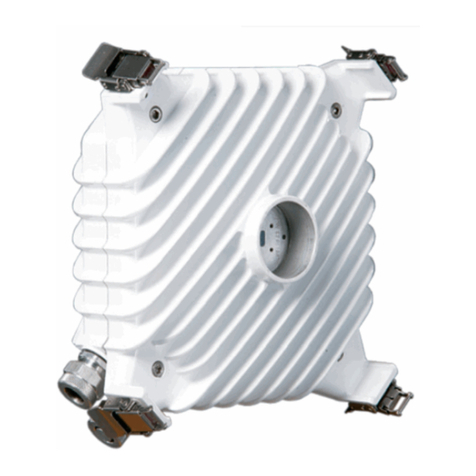
Exalt
Exalt rc06020 FCC Programming manual

Exalt
Exalt ExtendAir G2 Programming manual
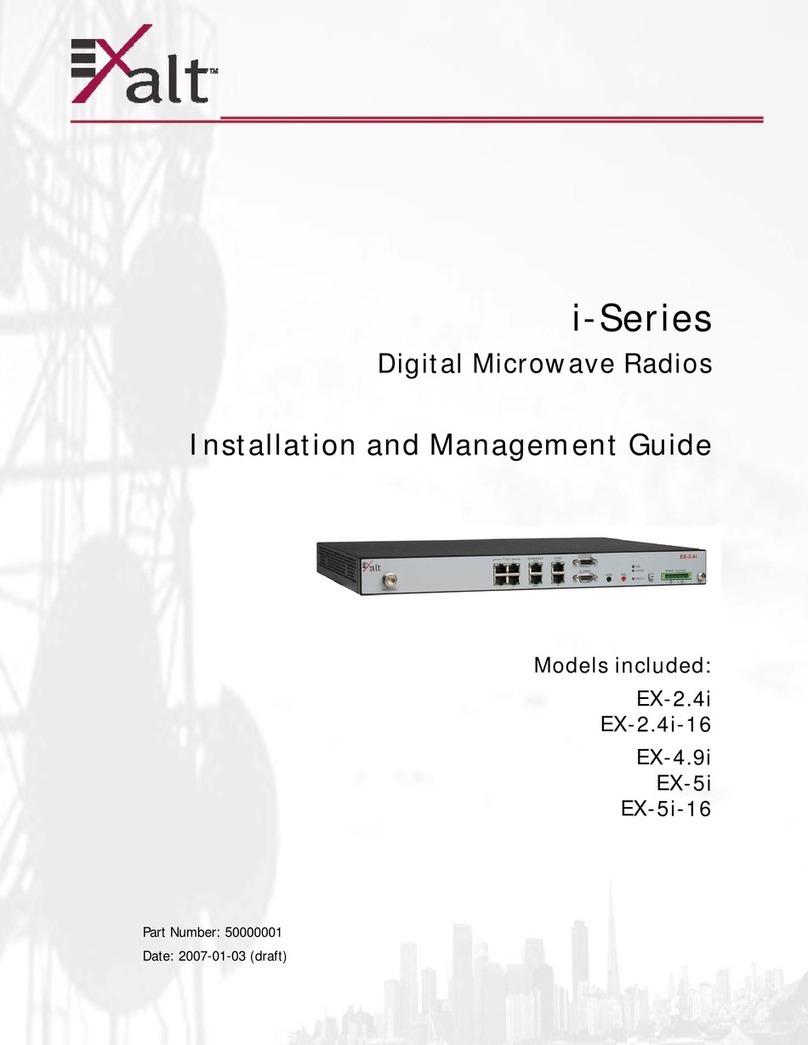
Exalt
Exalt EX-2.4i Lite Programming manual
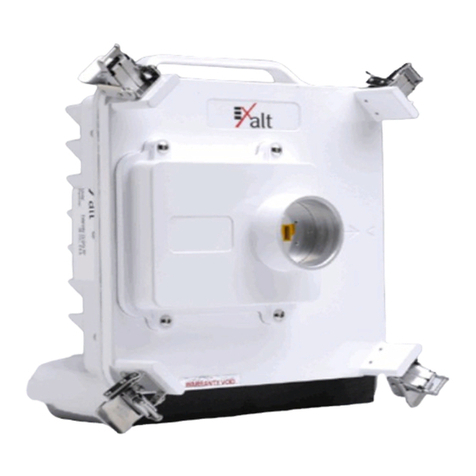
Exalt
Exalt ExtendAir series Programming manual

Exalt
Exalt ExtendAir r5015 Programming manual
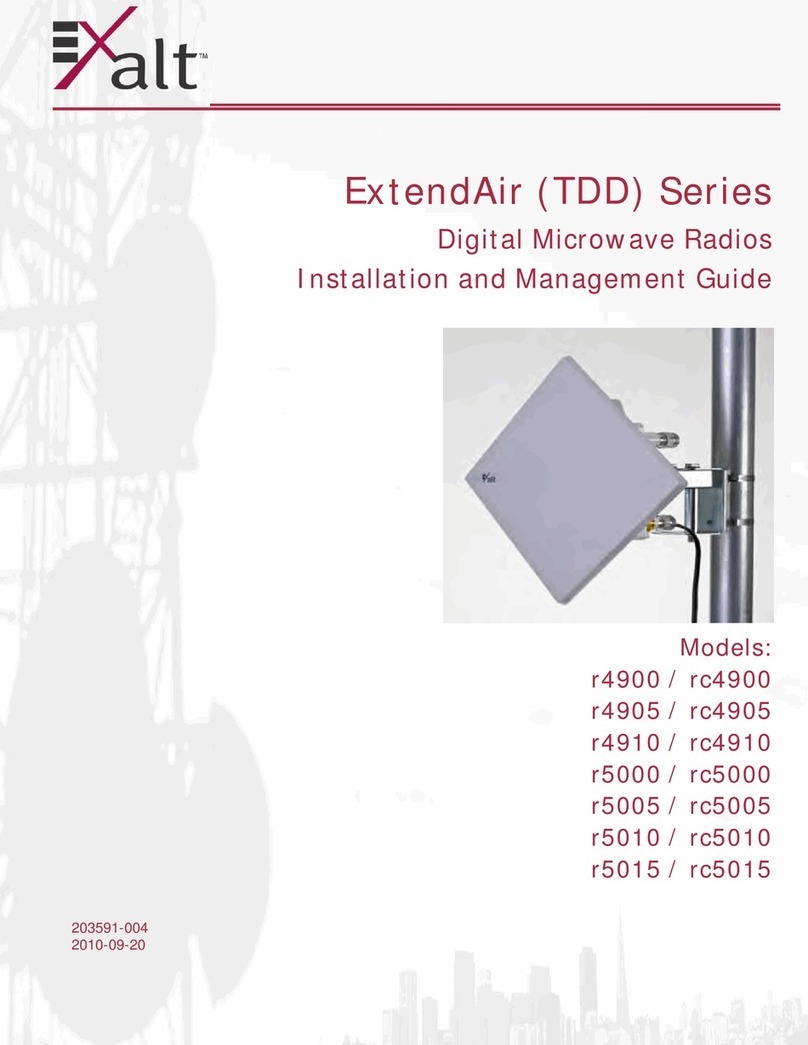
Exalt
Exalt ExtendAir r4900 Programming manual
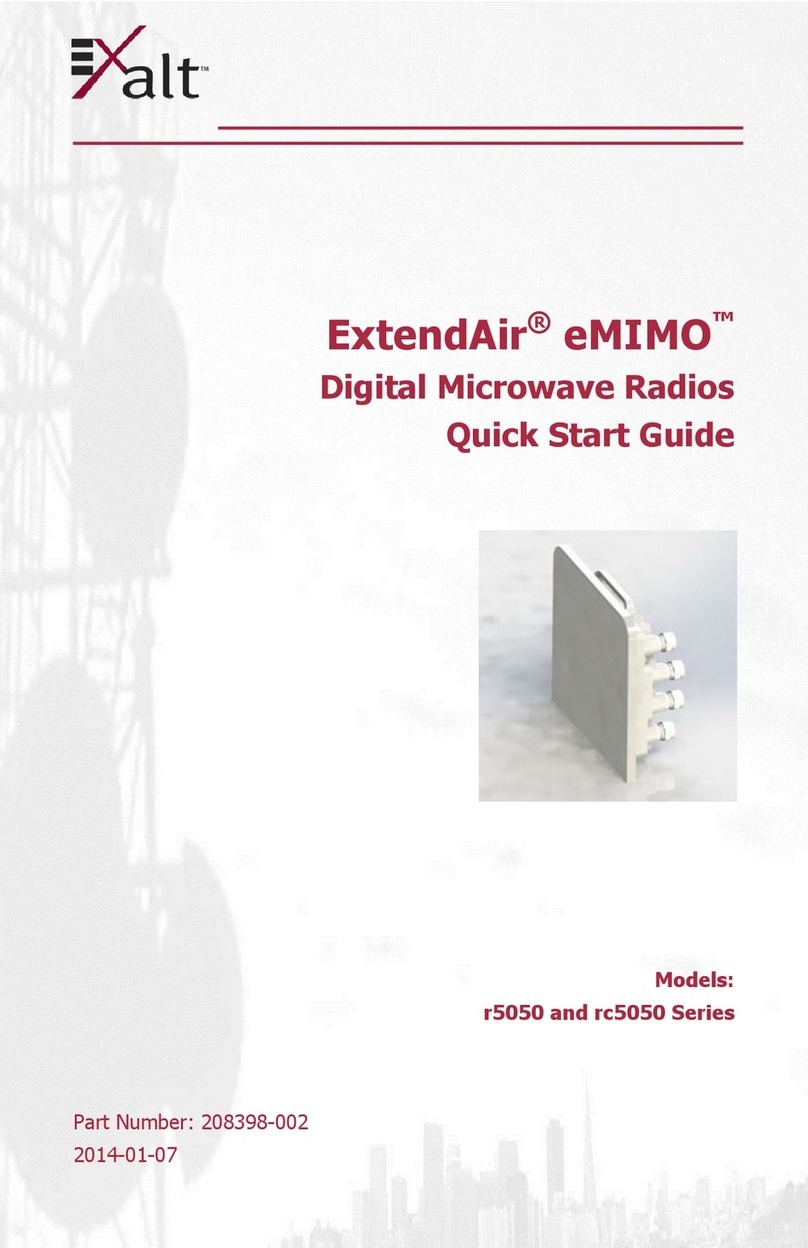
Exalt
Exalt ExtendAir eMIMO r5050 Series User manual
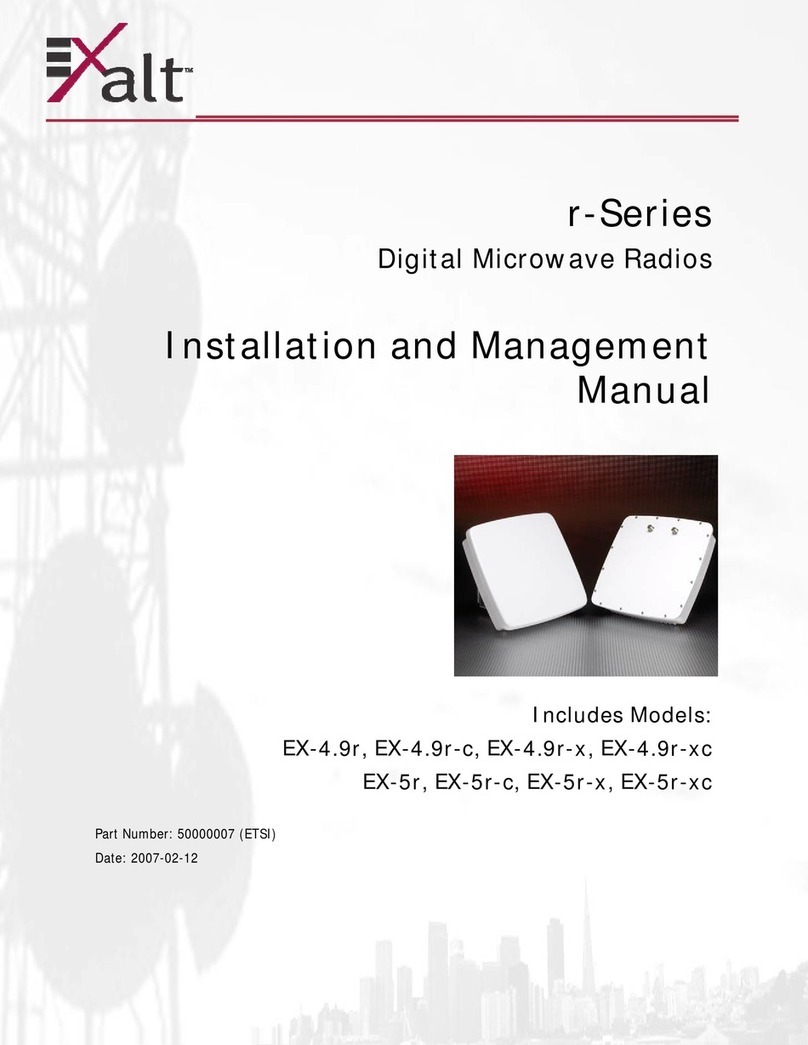
Exalt
Exalt r Series Manual

Exalt
Exalt ExtendAir series User manual

Exalt
Exalt EX-4.5r GigE Programming manual
